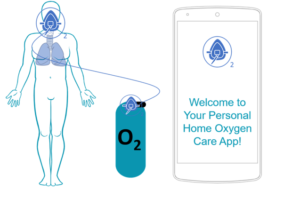Progress Report 3/1
This past Saturday we finally had the chance to visit an IPF patient. The visit opened our eyes to the real life of a patient on in-home IPF therapy and was an informative experience. From the visit, we updated our requirements for the device and application. The main issues we noticed were inconvenience using the oxygen concentrator and manual and inconsistent recording of the patient’s health information. The patient also had a lack of knowledge regarding what the oxygen liter flow should be set to. Our patient had the flow constant at all times and changed it arbitrarily as a consequence of feeling shortness of breath.
Device: We now have a concentrator to perform tests on. We are now in the process of testing a prototype of the device to optimize it for the concentrator. We are doing this using Arduino code and are optimizing the sensitivity of the motor so that it turns the correct amount with each rotation. We are also considering editing the device design in order to create a locking mechanism on the section that connects to the concentrator. This will allow the device to maintain its position and will reduce the risk that the oxygen flow will change without input.
Application
These are the new application requirements we have developed are:
1. The application must be effective
1.1 Must determine O2 liter flow rates based on clinically & scientifically accurate data
1.2 Must adjust the O2 liter flow rate based on the specific patient’s blood O2 sat level
1.3 Should include suggested O2 liter flow rates based on disease severity
1.4 Should allow the user to track their O2 saturation and liter flow requirement in relation to their physical activity
2. The application must be easy to navigate
2.1 Should have adjustable font sizes for the geriatric population
2.2 Must contain a help option containing usage tips
3. The application must be secure
3.1 Must collect user information into separate accounts
3.2 Must require authentication to access user account
4. The application must be easily implementable
4.1 Must be free for download
4.3 Must be able to use on all Android devices on all software versions
Most of it remains the same, however, we realized that our patients do not move around much, and after finalizing our protocol with Dr. Lancaster we believe it isn’t necessary to really adjust for changes in short term physical activity based on standard data we would collect by selecting the activity on the application. We will instead adjust after the fact if their blood oxygen concentration had decreased. Out application will send reminders to the patient to check their O2 saturation at various times throughout the day and adjust the oxygen liter flow according to their blood oxygen saturation value. We are thinking of either sending this reminder at certain times throughout the day or when the phone detects increased motion.
For the front end design, we have purchased builder x which uses react native. We plan to have a prototype of our front end design complete within the next couple of weeks
Our updated steps/pages needed for front end design are
Step 1:
Option 1: Log-In
Option 1a: Enter email or phone number and password
Option 2: Create a new account
Option 2a: Enter name
Option 2b: Enter email
Option 2c: Enter the phone number
Option 3c: Enter age
Option 3d: Enter gender
Option 3e: Enter baselines O2 level
Option 3f: Enter the password
Option 3g: Re-enter password
Step 2:
Option 1: Adjust Your Device
Option 1a: Input blood O2 saturation level
Option 2a: Manually input desired oxygen liter flow rate
Option 2: Access Your Account
Option 2a: View O2 saturation values overtime classified by activity level and O2 liter flow rate
Option 3b: Edit your account information
Option 3: Settings
Option 3a: Choose your oxygen concentrator
Option 3b: Adjust font size
Option 3c: Log out
Option 4: Help
Option 4a: How to use this application
Option 4b. View Suggested Oxygen Liter Flow Guide
React native will also be used in coding the protocol that Dr. Lancaster has recommended. This protocol will consist of the patient using the application inputting their measured blood oxygen saturation level and adjusting the flow rate on the oxygen concentrator accordingly. The app will communicate with the Arduino on the device to make the physical changes.
Protocol

Finally, we are in the process of changing our presentation with the goal of visually delivering complicated information. This was based on feedback from our presentation sessions.
Old Version:

New Version:

We have also chosen a final design for our illustration:


Leave a Response